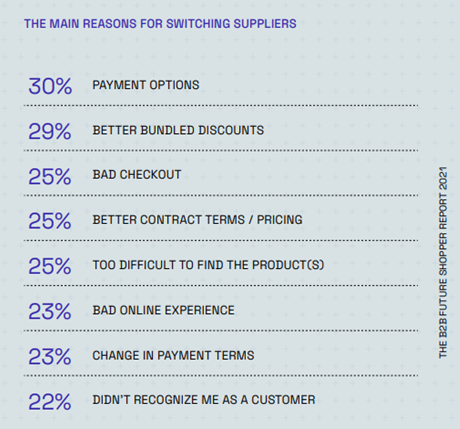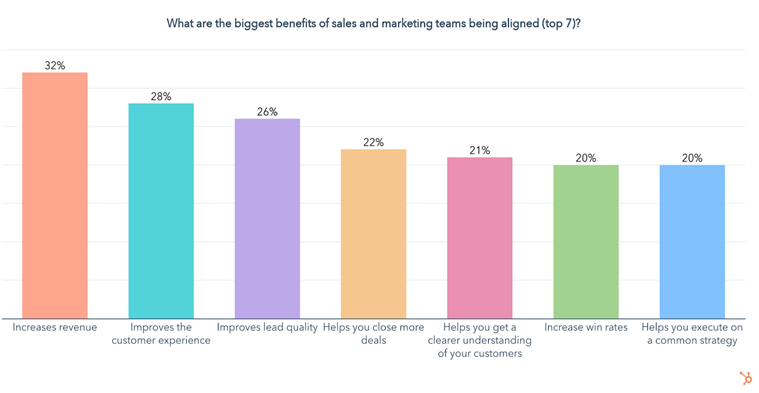Traditionally, sales and marketing teams have a strained, disconnected relationship. Sales teams blame marketing for delivering low-quality leads, whereas marketing blames sales for failing to close deals.
Sales and marketing ("smarketing") metrics can tell you how effectively your sales and marketing teams are working together. And, yes, your sales and marketing teams have to work together.
Fully 90% of sales and marketing professionals agree that when initiatives and messages are aligned, they have a positive impact on customer experience.
Sales and marketing alignment refers to when the two departments unify their strategies and integrate their processes to meet shared goals. B2B companies that align their sales and marketing teams drive higher revenue growth, win rates, customer retention, and more.
How aligned are your sales and marketing teams? Are they both focusing on the right metrics to meet their shared goals?
Let's take a look at the smarketing metrics that you should be tracking to answer those questions.
Seven Metrics to Measure Sales and Marketing Alignment
1. Cost per lead
Cost per lead (CPL) calculates the average cost of generating new sales leads. Specifically, it measures the cost-effectiveness of individual marketing campaigns.
For example, knowing how to track email opens in Gmail, along with your clickthrough rate and conversion rate, can give you insight into the success of your email marketing campaigns. But CPL tells you whether the campaign was actually profitable, regardless of how many conversions it generated.
Aligned sales and marketing teams have a lower CPL because they collaboratively evaluate campaign profitability, set sales goals, and adjust advertising budgets.
2. Marketing-qualified leads
A Marketing-qualified lead (MQL) is a prospective customer who is ready to be handed over to your sales department. MQL leads are identified by Marketing once they've completed actions that show purchasing interest.
So, an MQL for a B2B company might be someone who signs up for your product demo, attends one of your webinars, or downloads your e-book.
If your MQL rate is low, it could indicate a misalignment in communication. When Sales and Marketing are misaligned, Sales ends up wasting time trying to nurture leads that have low buying potential. But if you improve communication between the teams, refine sales criteria, and streamline the handoff process, you'll improve the quantity and quality of leads.
Sales and Marketing need to collectively establish what qualifies as a high-quality lead to maximize the effectiveness of MQLs. Along with specific intent-to-buy actions, define the customer characteristics of a high-quality lead.
3. Sales-qualified leads
Sales-qualified leads (SQLs) are MQLs that have demonstrated direct buying intent. They have all of the information, resources, and executive buy-in that they need to make a decision; they are ready to speak to a salesperson.
Understanding how leads travel down the sales pipeline from MQL to SQL gives both teams insights into the strengths and weaknesses of your pipeline. They can analyze where and why leads drop out of the funnel, and then make targeted improvements in the right areas.
A slow SQL stream could indicate a leak in your sales funnel, but don't be fooled by the name. It should be thought of as a marketing and sales funnel, and it's crucial that every stage of the funnel—from awareness to purchase—be aligned. It's not enough for the marketing team to hand off an MQL; it must ensure each lead continues its journey through to purchase.
If you find your SQLs need improving and leads are leaking through, it's time for the sales and marketing teams to review the data and find ways to optimize the funnel at every stage.
4. Customer retention rate
These days, even using the best PaaS and delivering a great product isn't enough to secure customer loyalty.
In the US, 96% of B2B buyers admit to switching brands for reasons other than the quality of the product or service.

Source: wundermanthompson.com
Traditionally, the responsibility for a poor customer retention rate has been ascribed to the sales team. But it could indicate poor alignment in Sales and Marketing. Your retention rate is an excellent indicator of lead quality, so assessing the metric will help you identify what stages you're losing customers so you can collaborate on improvements.
Both teams need to be able to recognize the channels, campaigns, and customer personas that commonly drive retention. They also need to create streamlined, consistent experiences for customers who meet the criteria for high retention potential.
Doing so requires that both teams to work from a single source of truth. It's the case for all inter-relational teams—for software and development teams, it's GitOps. For HR and finance, it's HR accounting software. And for sales and marketing teams, it's a unified CRM.
A unified CRM gives both teams access to the same rich, real-time customer data. Sales and marketing teams can view all of their customers' previous brand interactions, enabling them to deliver consistent, personalized communications that drive customer retention.
In addition, a well-implemented client portal can further enhance the customer experience by providing self-service options and direct communication channels.
5. Customer acquisition cost
Customer acquisition cost (CAC) is one of the main B2B sales metrics that influence marketing strategies. CAC approximates how much you spend on acquiring a new customer. It's calculated by adding together your marketing and sales expenses and then dividing the total by the number of new customers.
A high CAC often suggests that sales and marketing priorities exist in silos. To reduce CAC, collaboratively identify customer journey touchpoints that can be streamlined and optimized.
6. Revenue/marketing-revenue attribution
Measuring your total revenue is a vital key performance indicator (KPI). It gives you a top-level view of your company's overall health and success, which can influence ideas for business growth.
Revenue is often considered a direct result of sales efforts. But by specifically measuring marketing-generated revenue, you can more clearly see revenue generated from each marketing channel. That allows you to identify the specific marketing campaigns, channels, and activities that result in revenue—to then make more focused, impactful decisions in the future.
The customer journey is no longer straightforward; there are multiple touchpoints and channels throughout every stage. So by identifying marketing-revenue attribution, you can identify the channels your leads are engaging with most.
When measuring this metric, keep in mind that low ROI may not necessarily indicate your sales and marketing teams are misaligned. However, it does present an opportunity to align the performance of both teams throughout the sales and marketing funnel, from awareness to conversion.
Use this metric to track how each element of the marketing team's strategy affects sales, and collaboratively map out the sales cycle. By identifying and communicating which channel leads to the greatest number of new customers, both teams will have a clearer idea of how their efforts are connected.
In fact, 32% of sales professionals agree that increased revenue is the biggest benefit of sales and marketing alignment:

7. Opportunity-to-win ratio
Your opportunity-to-win ratio tells you how many qualified leads your sales team successfully converted into closed sales.
Using this KPI, you can identify sales reps who are good at initiating opportunities with leads but not so good at closing deals (or vice versa). Optimize your sales team by putting the right people in the right places, simultaneously training them in areas that they aren't as competent in.
Of course, every company wants a high opportunity-to-win ratio, and it's certainly an excellent indicator of alignment. Measure this metric and you'll know your marketing team is consistently generating high-quality leads that move smoothly down the funnel for your sales team to convert (and keep).
* * *
The more aligned your teams are, the more power you're able to channel into meeting your overall business goals.
Tracking smarketing metrics can illuminate gaps in Sales and Marketing alignment. It can also unlock lucrative opportunities for business growth.
More Resources on Smarketing and Sales & Marketing Alignment
Compete or Cooperate: What Should Marketing and Sales Teams Do?
Six Best-Practices to Improve Sales and Marketing Alignment
Can't We All Just Get Along? Why Sales and Marketing Need to Work Together
The Power of 'Smarketing' (Marketing and Sales Alignment) [Infographic]




